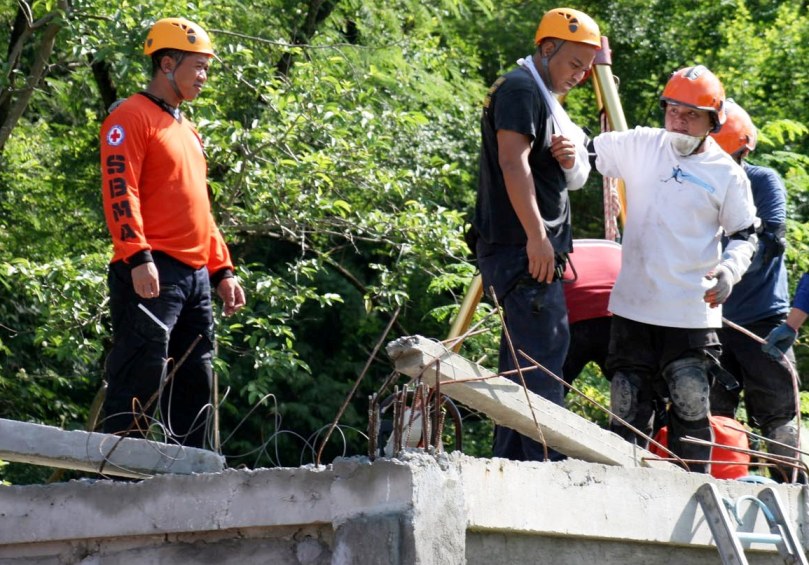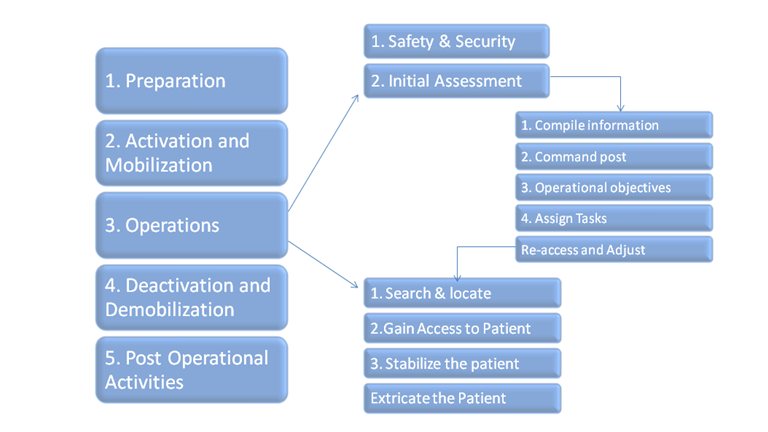Organizing and Starting a CSSR Operation
- Define a collapsed structure search and rescue operation.
- Describe the structure of a CSSR squad and the positions within it.
- List the five phases of a CSSR operation.
- List the six stages of the Operations Phase.
- List the five steps of the initial assessment.
- Describe how a CSSR squad fits into the incident Command System.
- Name the four levels in the scope of operations as they pertain to CSSR.

Jump to Heading
What is CSSR:
- According to the us National Fire Protection Act (NFPA 1670)’ CSSR is an Operation to conduct safe and effective Search and Rescue operation at collapsed structure incidents involving the Collapsed or Failure of reinforced and unreinforced masonry, concrete, tilt-up and heavy timber construction.
The CSSR Squad:
- An active component of an emergency response system whose purpose is to search for, locate, gain access to, stabilize and extricate trapped victims from a collapsed structure.

(L)- Squad members rotate positions as Logistics Person
Brief overview of function Assigned to the members of a CSSR squad.
Squad Leader:
- Communicate with the Command Post (CP) I Emergency Operations Centre (EOC).
- Receive work instructions.
- Assign tasks to the rescuers.
- Decide which tools should be used to perform specific tasks.
- Monitor work rotations.
- Update the CP on progress end completed tasks.
- Safety officer for the squad.
- Maintain a log of all events, actions, and expenditures
Rescuers:
- Carry out work instructions from the Squad Leader.
- Use the tools, equipment and accessories correctly and safely.
- Update the squad leader on task progress.
- Request to the Squad Leader the resources necessary to complete the task.
Logistics position:
The Logistics position is a rotating position within the squad. He/she is responsible for the tools, equipment and accessories and other resources; squad members will take turns assuming this responsibility.

Phase I: Preparation (ongoing, before disaster)
- Selection of team members
- Training of team members
- Personal protective equipment (PPE)
Tools and equipment very important to maintain in proper working condition and ready for mobilization to work site.
Make general transportation arrangements.
Phase II- Activation and Mobilization (request to respond)
- Request Transportation.
- Pack and Load Equipment.
- Notify team members.
Obtain information on Disaster. This Includes information such as type, location and topography, magnitude/area, number of people affected, number of buildings affected, weather, access routes.
Brief team members on current situation.
The initial assessment consists of the following five steps:
Step 1. Compile Information Once at the scene, consult local authorities, gather data and conduct a needs analysis.
Confirm and update all information obtained in the activation phase.
Step 2. Establish Command Post outside the hot zone.
Step 3. Establish Operational objectives such as:
- general access to the disaster site
- strategic planning and priorities
- allocating resources and personnel managing operations begun by neighbors or other organizations
Step 4. Assign tasks to rescue squads.
Reassesses the situation and make necessary adjustments.
Step 5. Reassesses the situation and make necessary adjustments.
Stage 3: Search and Locate
Conduct a search using a specific set of techniques to obtain a response ) or indications of the presence of live victims in a void space inside a collapsed structure.
Stage 4: Gain Access to the Victim
Remove rubble, break and breach materials and create a passageway to I access the void space where a live victim is believed to be located.
Stage 5: Stabilize the Victim
Perform basic life support on-site before extricating the patient in order to I improve later chances of survival. You will hand off the patient to more! advanced medical care after extrication.
Stage 6: Extricate the patient
Remove rubble surrounding the patient, ensuring no further injury. Shore Ensure no additional pressure Is applied to any trapped of the body
Phase IV: deactivation and demobilization
Confirm no other operations are needed.
Account for all tools and equipment. Prepare tools and equipment and pack them for transportation.
Confirm that personnel have all their personal items.
Arrange for transportation.
Phase V: Post-Operational Activities
Critical Incident Stress Management (CISM)
Medical physical examinations for
rescue personnel
Equipment rehabilitation.
After-Action Report for institutional management.
Operational safety with rescue team.
4. Incident Command System
Definition: A flexible system for managing people and resources.
The Incident Command System (ICS) provides a clear management framework for all types of small and large-scale incidents such and multiple
casualty, multi jurisdictional and multi-agency disasters, and wide area search and rescue operations. Organization of the ICS is built around the major management.
These five elements are the foundation upon which the ICS organization develops. They apply whether handling a routine emergency, organizing a major event, or managing a major response to a disaster. The most commonly used elements are the Incident Commander and Operation Section.
4.1 Incident Commander
The Incident Commander (IC) is the person in charge at the incident who must be fully qualified to manage the incident. As incidents grow in size or become increasingly complex, a more highly qualified IC may be assigned by the responsible jurisdiction or agency.
The sole function of the IC is to manage the incident by assigning tactical resources and overseeing operations, delegating authority to others as required. The IC should not become involved in hands on activities
4.2 Incident Command Post
The Incident Command Post (ICP) is the location from which the IC oversees all incident operations. There is only one ICP for each incident or event. Every incident or event must have some form of an Incident Command Post. The various section chiefs and Incident Commander’s support staff will work out of the ICP.
5. Scope of Operation In a large-scale emergency such as an earthquake, the area of impact will usually be over a wide area, possibly covering many cities. As a result, the incident will be managed by different groups at various levels, depending on their type of responsibility.
The work site is the scope of operation for a CSSR squad. As a member of a CSSR squad, you will be concerned only with performing rescue work on a specific site. Coordination on a larger scale will be taken care of by personnel at a different level of administration.

Emma Lee, an expert in fire safety with years of firefighting and Rescuer experience, writes to educate on arescuer.com, sharing life-saving tips and insights.
